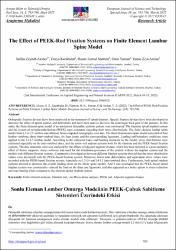| dc.contributor.author | Arslan, Yunus Ziya | |
| dc.contributor.author | Akıncı, Saliha Zeyneb | |
| dc.contributor.author | Yaman, Onur | |
| dc.contributor.author | Sürmen, Hasan Kemal | |
| dc.contributor.author | Karabulut, Derya | |
| dc.date.accessioned | 2024-04-24T17:12:56Z | |
| dc.date.available | 2024-04-24T17:12:56Z | |
| dc.date.issued | 2022 | en_US |
| dc.identifier.citation | Akıncı, S. Z., Karabulut, D., Sürmen, H. K., Yaman, O. (2022). The effect of PEEK-Rod fixation systems on finite element lumbar spine model. Avrupa Bilim Ve Teknoloji Dergisi(34), 783-786. | en_US |
| dc.identifier.uri | https://hdl.handle.net/20.500.12846/1142 | |
| dc.description.abstract | Orthopedic fixation devices have been employed in the treatment of spinal diseases. Special fixation devices have been developed to
decrease the effect of spinal injuries and deformities and have been used to decrease the neurologic back pain of the patients. In this
study, the finite element spine model of an adolescent idiopathic scoliotic patient was constructed. The titanium spinal implant system
and the system of polyetheretherketone (PEEK) were compared regarding their stress distributions. The finite element lumbar spine
model from L2 to L5 vertebra was obtained from computed tomography scan data. The three-dimensional spine model consisted of four
lumbar vertebrae, three intervertebral discs, six facet joints, and the corresponding ligaments. Loading and boundary conditions were
applied to the L2-L5 lumbar model. According to the subjected loads and bending moments on the model, stress distributions were
evaluated especially on the intervertebral discs, and the screw-rod implant systems both for the titanium and the PEEK-based fixation
systems. The disc structures were also analyzed for the effects of adjacent segment disease, which has been reported as a post-operative
effect of fusion surgeries. Ansys software was used for the simulation processes of the models without the implant system and the
models with different fixation systems. Comparative investigation between different fixation systems showed that the stress distribution
values were decreased with the PEEK-based fixation system. Moreover, lower total deformation and equivalent stress values were
recorded with the PEEK-based fixation system, especially on L3-L4 and L4-L5 intervertebral discs. Furthermore, both spinal implant
systems allowed to decrease the overall loading stress on the whole spine models. And it was concluded that the PEEK-based spinal
implant system was considerably reduced the load on the discs and ligaments, and also appeared as a better option in stress reduction
and load sharing when compared to the titanium spinal implant system. | en_US |
| dc.description.abstract | Ortopedik sabitleme cihazları omurga rahatsızlıklarının tedavisinde kullanılmaktadır. Özel sabitleme cihazları omurga rahatsızlıklarının
ve deformitelerinin etkilerini azaltmak ve hastaların nörolojik sırt ağrılarını hafifletmek için geliştirilmektedir. Bu çalışmada adolesan
idiyopatik bir hastanın omurgasının sonlu eleman modeli elde edilmiştir. Titanyum ve polietereterketon (PEEK) omurga implant
sistemleri stres dağılımları göz önüne alınarak karşılaştırılmıştır. Sonlu eleman lomber omurga modeli L2’den L5’e kadar bilgisayarlı tomografi verilerinden elde edilmiştir. Üç-boyutlu omurga modeli dört tane lomber omurundan, üç tane omurlararası diskten, altı tane
faset eklemden ve bunlara karşılık gelen ligamentlerden oluşmaktadır. L2-L5 lomber modele yükleme ve sınır koşulları uygulanmıştır.
Model üzerinde uygulanan yüklere ve eğilme momentlerine göre gerilme dağılımları, özellikle omurlararası disklerde ve vida-çubuk
implant sistemleri üzerindeki etkileri titanyum ve PEEK-tabanlı sabitleme cihazlarının her ikisi için de değerlendirilmiştir. Disk yapıları
ayrıca füzyon ameliyatlarının operasyon sonrası etkileri olarak rapor edilen komşu segment hastalığının etkileri açısından da
araştırılmıştır. İmplantsız ve farklı sabitleme cihazlarının olduğu sistemlerdeki simülasyon işlemleri için Ansys programı kullanılmıştır.
Farklı sabitleme sistemleri arasında yapılan karşılaştırmalı araştırma, PEEK-tabanlı sabitleme sisteminde daha düşük gerilme dağılımı
değerlerinin olduğunu göstermiştir. Buna ek olarak, PEEK-tabanlı sabitleme sisteminde daha düşük toplam deformasyon ve eşdeğer
gerilme değerleri, özellikle L3-L4 ve L4-L5 omurlararası disklerde kaydedilmiştir. Ayrıca her iki omurga implant sistemi, bütün omurga
modeli üzerindeki toplam yükleme stresinin azalmasına imkan vermiştir. PEEK-tabanlı omurga implant sisteminin diskler ve
ligamentler üzerindeki yükü önemli ölçüde azalttığı, ve de titanyum omur implant sistemi ile karşılaştırıldığında stres değerlerinin
azaltılmasında ve yük paylaşımında daha iyi bir seçenek olduğu sonucuna varılmıştır. | en_US |
| dc.language.iso | eng | en_US |
| dc.publisher | Avrupa Bilim Ve Teknoloji Dergisi | en_US |
| dc.relation.isversionof | 10.31590/ejosat.1086952 | en_US |
| dc.rights | info:eu-repo/semantics/openAccess | en_US |
| dc.subject | Sonlu eleman analizi | en_US |
| dc.subject | Titanyum çubuk | en_US |
| dc.subject | von Mises gerilme analizi | en_US |
| dc.subject | PEEK çubuk | en_US |
| dc.subject | Komşu segment hastalığı | en_US |
| dc.subject | Finite element analysis | en_US |
| dc.subject | Titanium rod | en_US |
| dc.subject | von Mises stress analysis | en_US |
| dc.subject | PEEK rod | en_US |
| dc.subject | Adjacent segment disease | en_US |
| dc.title | The effect of PEEK-Rod fixation systems on finite element lumbar spine model | en_US |
| dc.type | article | en_US |
| dc.contributor.authorID | 0000-0002-1861-9368 | en_US |
| dc.identifier.issue | 34 | en_US |
| dc.relation.publicationcategory | Makale - Ulusal Hakemli Dergi - Kurum Öğretim Elemanı | en_US |
| dc.contributor.department | TAÜ, Fen Bilimleri Enstitüsü, Robotlar ve Akıllı Sistemler Ana Bilim Dalı Koleksiyonu | en_US |
| dc.identifier.startpage | 783 | en_US |
| dc.identifier.endpage | 786 | en_US |

















